Inflammation and Elevated Osteopontin in Plasma and CSF in Cerebral Malaria Compared to Plasmodium-Negative Neurological Infections
Abstract
1. Introduction
2. Results and Discussion
2.1. Analyte Differences between the CM and Non-CM Group
2.1.1. Higher IP10 Levels in Plasma in CM but Not in CSF
2.1.2. Elevated GRO Chemokines in Both CM and Non-CM Patients
2.1.3. Detected Levels of MIP3-α, IL23, and MCP1 in Both CM and Non-CM Patients
2.1.4. Elevated OPN Levels in Both Plasma and CSF of CM Patients
3. Materials and Methods
3.1. Participants and Sample Collection
3.2. Determination of Plasma and CSF Analytes
3.3. Statistical Analysis and Graphing
Supplementary Materials
Author Contributions
Funding
Institutional Review Board Statement
Informed Consent Statement
Data Availability Statement
Conflicts of Interest
Abbreviations
| ALT | Alanine transaminase |
| Ang | Angiopoietin |
| AST | Aspartate transaminase |
| BBB | Blood–brain barrier |
| CM | Cerebral malaria |
| CNS | Central nervous system |
| CSF | Cerebrospinal fluid |
| GCS | Glasgow Coma Scale |
| GRO | Growth-related oncogene |
| IFNγ | Interferon gamma |
| IL | Interleukin |
| IP10 | Interferon-inducible protein of 10kDa |
| IQR | Interquartile ranges |
| KDa | Kilo Dalton |
| L | Lumbar |
| MCH | Mean corpuscular hemoglobin |
| MCHC | Mean corpuscular hemoglobin concentration |
| MCP-1 | Macrophage chemotactic proteins-1 |
| MCV | Mean corpuscular volume |
| MIP1α | Macrophage inducible protein 3-alpha |
| OPN | Osteopontin |
| PDW | Platelet distribution width |
| PRBC | Plasmodium-infected red blood cells |
| Q1-Q3 | First and third quartiles of the data set. |
| RBC | Red blood cells |
| s-ICAM | Soluble intercellular adhesion molecule 1 |
| WBC | White blood cells |
References
- Birbeck, G.L.; Molyneux, M.E.; Kaplan, P.W.; Seydel, K.B.; Chimalizeni, Y.F.; Kawaza, K.; Taylor, T.E. Blantyre Malaria Project Epilepsy Study (BMPES) of neurological outcomes in retinopathy-positive paediatric cerebral malaria survivors: A prospective cohort study. Lancet Neurol. 2010, 9, 1173–1181. [Google Scholar] [CrossRef] [PubMed]
- Idro, R.; Jenkins, N.E.; Newton, C.R. Pathogenesis, clinical features, and neurological outcome of cerebral malaria. Lancet Neurol. 2005, 4, 827–840. [Google Scholar] [CrossRef] [PubMed]
- Schiess, N.; Villabona-Rueda, A.; Cottier, K.E.; Huether, K.; Chipeta, J.; Stins, M.F. Pathophysiology and neurologic sequelae of cerebral malaria. Malar. J. 2020, 19, 266. [Google Scholar] [CrossRef] [PubMed]
- Grab, D.J.; Chakravorty, S.J.; van der Heyde, H.; Stins, M.F. How can microbial interactions with the blood-brain barrier modulate astroglial and neuronal function? Cell Microbiol. 2011, 13, 1470–1478. [Google Scholar] [CrossRef]
- Asensio, V.C.; Maier, J.; Milner, R.; Boztug, K.; Kincaid, C.; Moulard, M.; Phillipson, C.; Lindsley, K.; Krucker, T.; Fox, H.S.; et al. Interferon-independent, human immunodeficiency virus type 1 gp120-mediated induction of CXCL10/IP10 gene expression by astrocytes in vivo and in vitro. J. Virol. 2001, 75, 7067–7077. [Google Scholar] [CrossRef]
- Lahrtz, F.; Piali, L.; Nadal, D.; Pfister, H.W.; Spanaus, K.S.; Baggiolini, M.; Fontana, A. Chemotactic activity on mononuclear cells in the cerebrospinal fluid of patients with viral meningitis is mediated by interferon-gamma inducible protein-10 and monocyte chemotactic protein-1. Eur. J. Immunol. 1997, 27, 2484–2489. [Google Scholar] [CrossRef]
- Quist-Paulsen, E.; Aukrust, P.; Kran, A.B.; Dunlop, O.; Ormaasen, V.; Stiksrud, B.; Midttun, Ø.; Ueland, T.; Ueland, P.M.; Mollnes, T.E.; et al. High neopterin and IP10 levels in cerebrospinal fluid are associated with neurotoxic tryptophan metabolites in acute central nervous system infections. J. Neuroinflamm. 2018, 15, 327. [Google Scholar] [CrossRef]
- Jain, V.; Armah, H.B.; Tongren, J.E.; Ned, R.M.; Wilson, N.O.; Crawford, S.; Joel, P.K.; Singh, M.P.; Nagpal, A.C.; Dash, A.P.; et al. Plasma IP10, apoptotic and angiogenic factors associated with fatal cerebral malaria in India. Malar. J. 2008, 7, 83. [Google Scholar] [CrossRef]
- Conroy, A.L.; Phiri, H.; Hawkes, M.; Glover, S.; Mallewa, M.; Seydel, K.B.; Taylor, T.E.; Molyneux, M.E.; Kain, K.C. Endothelium-based biomarkers are associated with cerebral malaria in Malawian children: A retrospective case-control study. PLoS ONE 2010, 5, e15291. [Google Scholar] [CrossRef]
- Wangala, B.; Vovor, A.; Gantin, R.G.; Agbeko, Y.F.; Lechner, C.J.; Huang, X.; Soboslay, P.T.; Köhler, C. Chemokine levels and parasite- and allergen-specific antibody responses in children and adults with severe or uncomplicated Plasmodium falciparum malaria. Eur. J. Microbiol. Immunol. 2015, 5, 131–141. [Google Scholar] [CrossRef]
- Armah, H.B.; Wilson, N.O.; Sarfo, B.Y.; Powell, M.D.; Bond, V.C.; Anderson, W.; Adjei, A.A.; Gyasi, R.K.; Tettey, Y.; Wiredu, E.K.; et al. Cerebrospinal fluid and serum biomarkers of cerebral malaria mortality in Ghanaian children. Malar. J. 2007, 6, 147. [Google Scholar] [CrossRef] [PubMed]
- Kunii, Y.; Niwa, S.; Hagiwara, Y.; Maeda, M.; Seitoh, T.; Suzuki, T. The immunohistochemical expression profile of osteopontin in normal human tissues using two site-specific antibodies reveals a wide distribution of positive cells and extensive expression in the central and peripheral nervous systems. Med. Mol. Morphol. 2009, 42, 155–161. [Google Scholar] [CrossRef]
- Brown, L.F.; Berse, B.; Van de Water, L.; Papadopoulos-Sergiou, A.; Perruzzi, C.A.; Manseau, E.J.; Dvorak, H.F.; Senger, D.R. Expression and distribution of osteopontin in human tissues: Widespread association with luminal epithelial surfaces. Mol. Biol. Cell 1992, 3, 1169–1180. [Google Scholar] [CrossRef]
- Jiang, R.; Prell, C.; Lönnerdal, B. Milk osteopontin promotes brain development by up-regulating osteopontin in the brain in early life. FASEB J. 2019, 33, 1681–1694. [Google Scholar] [CrossRef]
- O’Brien, E.R.; Garvin, M.R.; Stewart, D.K.; Hinohara, T.; Simpson, J.B.; Schwartz, S.M.; Giachelli, C.M. Osteopontin is synthesized by macrophage, smooth muscle, and endothelial cells in primary and restenotic human coronary atherosclerotic plaques. Arterioscler. Thromb. 1994, 14, 1648–1656. [Google Scholar] [CrossRef] [PubMed]
- Jiang, R.; Lönnerdal, B. Biological roles of milk osteopontin. Curr. Opin. Clin. Nutr. Metab. Care 2016, 19, 214–219. [Google Scholar] [CrossRef]
- Wang, K.X.; Denhardt, D.T. Osteopontin: Role in immune regulation and stress responses. Cytokine Growth Factor Rev. 2008, 19, 333–345. [Google Scholar] [CrossRef]
- Ashkar, S.; Weber, G.F.; Panoutsakopoulou, V.; Sanchirico, M.E.; Jansson, M.; Zawaideh, S.; Rittling, S.R.; Denhardt, D.T.; Glimcher, M.J.; Cantor, H. Eta-1 (osteopontin): An early component of type-1 (cell-mediated) immunity. Science 2000, 287, 860–864. [Google Scholar] [CrossRef] [PubMed]
- Tiberti, N.; Sanchez, J.C. Comparative analysis of cerebrospinal fluid from the meningo-encephalitic stage of T. b. gambiense and rhodesiense sleeping sickness patients using TMT quantitative proteomics. Data Brief 2015, 4, 400–405. [Google Scholar] [CrossRef]
- Maeno, Y.; Nakazawa, S.; le Dao, D.; Van Tuan, N.; Giang, N.D.; Van Hanh, T.; Taniguchi, K. Osteopontin is involved in Th1-mediated immunity against Plasmodium falciparum infection in a holoendemic malaria region in Vietnam. Acta Trop 2006, 98, 305–310. [Google Scholar] [CrossRef]
- Bortell, N.; Flynn, C.; Conti, B.; Fox, H.S.; Marcondes, M.C.G. Osteopontin Impacts West Nile virus Pathogenesis and Resistance by Regulating Inflammasome Components and Cell Death in the Central Nervous System at Early Time Points. Mediat. Inflamm. 2017, 2017, 7582437. [Google Scholar] [CrossRef] [PubMed]
- Xia, M.; Hyman, B.T. GROalpha/KC, a chemokine receptor CXCR2 ligand, can be a potent trigger for neuronal ERK1/2 and PI-3 kinase pathways and for tau hyperphosphorylation-a role in Alzheimer’s disease? J. Neuroimmunol. 2002, 122, 55–64. [Google Scholar] [CrossRef] [PubMed]
- Filipovic, R.; Jakovcevski, I.; Zecevic, N. GRO-alpha and CXCR2 in the human fetal brain and multiple sclerosis lesions. Dev. Neurosci. 2003, 25, 279–290. [Google Scholar] [CrossRef] [PubMed]
- Lax, P.; Limatola, C.; Fucile, S.; Trettel, F.; Di Bartolomeo, S.; Renzi, M.; Ragozzino, D.; Eusebi, F. Chemokine receptor CXCR2 regulates the functional properties of AMPA-type glutamate receptor GluR1 in HEK cells. J. Neuroimmunol. 2002, 129, 66–73. [Google Scholar] [CrossRef]
- Giovannelli, A.; Limatola, C.; Ragozzino, D.; Mileo, A.M.; Ruggieri, A.; Ciotti, M.T.; Mercanti, D.; Santoni, A.; Eusebi, F. CXC chemokines interleukin-8 (IL-8) and growth-related gene product alpha (GROalpha) modulate Purkinje neuron activity in mouse cerebellum. J. Neuroimmunol. 1998, 92, 122–132. [Google Scholar] [CrossRef]
- Stins, M. Differences in Brain Derived Neurotrophic Factor and Interleukin-6 levels in plasma and Cerebrospinal Fluid in Cerebral Malaria and Meningitis. J. Neurol. Sci. 2023, 450, 120663. [Google Scholar] [CrossRef]
- Xia, M.Q.; Hyman, B.T. Chemokines/chemokine receptors in the central nervous system and Alzheimer’s disease. J. Neurovirol. 1999, 5, 32–41. [Google Scholar] [CrossRef]
- Bhowmick, S.; Duseja, R.; Das, S.; Appaiahgiri, M.B.; Vrati, S.; Basu, A. Induction of IP10 (CXCL10) in astrocytes following Japanese encephalitis. Neurosci. Lett. 2007, 414, 45–50. [Google Scholar] [CrossRef]
- Cheeran, M.C.; Hu, S.; Sheng, W.S.; Peterson, P.K.; Lokensgard, J.R. CXCL10 production from cytomegalovirus-stimulated microglia is regulated by both human and viral interleukin-10. J. Virol. 2003, 77, 4502–4515. [Google Scholar] [CrossRef]
- Kolb, S.A.; Sporer, B.; Lahrtz, F.; Koedel, U.; Pfister, H.W.; Fontana, A. Identification of a T cell chemotactic factor in the cerebrospinal fluid of HIV-1-infected individuals as interferon-gamma inducible protein 10. J. Neuroimmunol. 1999, 93, 172–181. [Google Scholar] [CrossRef]
- Yañez, D.M.; Batchelder, J.; van der Heyde, H.C.; Manning, D.D.; Weidanz, W.P. Gamma delta T-cell function in pathogenesis of cerebral malaria in mice infected with Plasmodium berghei ANKA. Infect. Immun. 1999, 67, 446–448. [Google Scholar] [CrossRef] [PubMed]
- Tran, V.; Weckman, A.M.; Crowley, V.M.; Cahill, L.S.; Zhong, K.; Cabrera, A.; Elphinstone, R.E.; Pearce, V.; Madanitsa, M.; Kalilani-Phiri, L.; et al. The Angiopoietin-Tie2 axis contributes to placental vascular disruption and adverse birth outcomes in malaria in pregnancy. EBioMedicine 2021, 73, 103683. [Google Scholar] [CrossRef]
- Kam, Y.W.; Ahmed, M.Y.; Amrun, S.N.; Lee, B.; Refaie, T.; Elgizouli, K.; Fong, S.W.; Renia, L.; Ng, L.F. Systematic analysis of disease-specific immunological signatures in patients with febrile illness from Saudi Arabia. Clin. Transl. Immunol. 2020, 9, e1163. [Google Scholar] [CrossRef] [PubMed]
- Chiaretti, A.; Pulitanò, S.; Conti, G.; Barone, G.; Buonsenso, D.; Manni, L.; Capozzi, D.; Ria, F.; Riccardi, R. Interleukin and neurotrophin up-regulation correlates with severity of H1N1 infection in children: A case-control study. Int. J. Infect. Dis. 2013, 17, e1186–e1193. [Google Scholar] [CrossRef] [PubMed][Green Version]
- Rubio, N.; Arevalo, M.A.; Cerciat, M.; Sanz-Rodriguez, F.; Unkila, M.; Garcia-Segura, L.M. Theiler’s virus infection provokes the overexpression of genes coding for the chemokine Ip10 (CXCL10) in SJL/J murine astrocytes, which can be inhibited by modulators of estrogen receptors. J. Neurovirol. 2014, 20, 485–495. [Google Scholar] [CrossRef]
- Darbinyan, A.; Kaminski, R.; White, M.K.; Darbinian-Sarkissian, N.; Khalili, K. Polyomavirus JC infection inhibits differentiation of oligodendrocyte progenitor cells. J. Neurosci. Res. 2013, 91, 116–127. [Google Scholar] [CrossRef]
- Caroline, A.L.; Kujawa, M.R.; Oury, T.D.; Reed, D.S.; Hartman, A.L. Inflammatory Biomarkers Associated with Lethal Rift Valley Fever Encephalitis in the Lewis Rat Model. Front. Microbiol. 2015, 6, 1509. [Google Scholar] [CrossRef]
- Popivanova, B.K.; Koike, K.; Tonchev, A.B.; Ishida, Y.; Kondo, T.; Ogawa, S.; Mukaida, N.; Inoue, M.; Yamashima, T. Accumulation of microglial cells expressing ELR motif-positive CXC chemokines and their receptor CXCR2 in monkey hippocampus after ischemia-reperfusion. Brain Res. 2003, 970, 195–204. [Google Scholar] [CrossRef]
- van Sorge, N.M.; Ebrahimi, C.M.; McGillivray, S.M.; Quach, D.; Sabet, M.; Guiney, D.G.; Doran, K.S. Anthrax toxins inhibit neutrophil signaling pathways in brain endothelium and contribute to the pathogenesis of meningitis. PLoS ONE 2008, 3, e2964. [Google Scholar] [CrossRef]
- Tripathi, A.K.; Sha, W.; Shulaev, V.; Stins, M.F.; Sullivan, D.J., Jr. Plasmodium falciparum-infected erythrocytes induce NF-kappaB regulated inflammatory pathways in human cerebral endothelium. Blood 2009, 114, 4243–4252. [Google Scholar] [CrossRef]
- Tripathi, A.K.; Sullivan, D.J.; Stins, M.F. Plasmodium falciparum-infected erythrocytes increase intercellular adhesion molecule 1 expression on brain endothelium through NF-kappaB. Infect. Immun. 2006, 74, 3262–3270. [Google Scholar] [CrossRef]
- Kim, J.M.; Oh, Y.K.; Lee, J.H.; Im, D.Y.; Kim, Y.J.; Youn, J.; Lee, C.H.; Son, H.; Lee, Y.S.; Park, J.Y.; et al. Induction of proinflammatory mediators requires activation of the TRAF, NIK, IKK and NF-kappaB signal transduction pathway in astrocytes infected with Escherichia coli. Clin. Exp. Immunol. 2005, 140, 450–460. [Google Scholar] [CrossRef]
- Vincent, A.J.; Choi-Lundberg, D.L.; Harris, J.A.; West, A.K.; Chuah, M.I. Bacteria and PAMPs activate nuclear factor kappaB and Gro production in a subset of olfactory ensheathing cells and astrocytes but not in Schwann cells. Glia 2007, 55, 905–916. [Google Scholar] [CrossRef] [PubMed]
- Pringle, N.; Collarini, E.J.; Mosley, M.J.; Heldin, C.H.; Westermark, B.; Richardson, W.D. PDGF A chain homodimers drive proliferation of bipotential (O-2A) glial progenitor cells in the developing rat optic nerve. EMBO J. 1989, 8, 1049–1056. [Google Scholar] [CrossRef]
- Robinson, S.; Tani, M.; Strieter, R.M.; Ransohoff, R.M.; Miller, R.H. The chemokine growth-regulated oncogene-alpha promotes spinal cord oligodendrocyte precursor proliferation. J. Neurosci. 1998, 18, 10457–10463. [Google Scholar] [CrossRef]
- Horuk, R.; Martin, A.W.; Wang, Z.; Schweitzer, L.; Gerassimides, A.; Guo, H.; Lu, Z.; Hesselgesser, J.; Perez, H.D.; Kim, J.; et al. Expression of chemokine receptors by subsets of neurons in the central nervous system. J. Immunol. 1997, 158, 2882–2890. [Google Scholar] [CrossRef] [PubMed]
- Nguyen, D.; Stangel, M. Expression of the chemokine receptors CXCR1 and CXCR2 in rat oligodendroglial cells. Dev. Brain Res. 2001, 128, 77–81. [Google Scholar] [CrossRef]
- Glabinski, A.R.; O’Bryant, S.; Selmaj, K.; Ransohoff, R.M. CXC chemokine receptors expression during chronic relapsing experimental autoimmune encephalomyelitis. Ann. N. Y. Acad. Sci. 2000, 917, 135–144. [Google Scholar] [CrossRef] [PubMed]
- Ragozzino, D.; Giovannelli, A.; Mileo, A.M.; Limatola, C.; Santoni, A.; Eusebi, F. Modulation of the neurotransmitter release in rat cerebellar neurons by GRO beta. Neuroreport 1998, 9, 3601–3606. [Google Scholar] [CrossRef]
- Ayimba, E.; Hegewald, J.; Segbena, A.Y.; Gantin, R.G.; Lechner, C.J.; Agosssou, A.; Banla, M.; Soboslay, P.T. Proinflammatory and regulatory cytokines and chemokines in infants with uncomplicated and severe Plasmodium falciparum malaria. Clin. Exp. Immunol. 2011, 166, 218–226. [Google Scholar] [CrossRef]
- Grygorczuk, S.; Zajkowska, J.; Swierzbinska, R.; Pancewicz, S.; Kondrusik, M.; Hermanowska-Szpakowicz, T. [Concentration of the beta-chemokine CCL5 (RANTES) in cerebrospinal fluid in patients with tick-borne encephalitis]. Neurol. Neurochir. Pol. 2006, 40, 106–111. [Google Scholar] [PubMed]
- Morahan, G.; Boutlis, C.S.; Huang, D.; Pain, A.; Saunders, J.R.; Hobbs, M.R.; Granger, D.L.; Weinberg, J.B.; Peshu, N.; Mwaikambo, E.D.; et al. A promoter polymorphism in the gene encoding interleukin-12 p40 (IL12B) is associated with mortality from cerebral malaria and with reduced nitric oxide production. Genes Immun. 2002, 3, 414–418. [Google Scholar] [CrossRef] [PubMed]
- Marquet, S.; Doumbo, O.; Cabantous, S.; Poudiougou, B.; Argiro, L.; Safeukui, I.; Konate, S.; Sissoko, S.; Chevereau, E.; Traore, A.; et al. A functional promoter variant in IL12B predisposes to cerebral malaria. Hum. Mol. Genet. 2008, 17, 2190–2195. [Google Scholar] [CrossRef]
- Ishida, H.; Matsuzaki-Moriya, C.; Imai, T.; Yanagisawa, K.; Nojima, Y.; Suzue, K.; Hirai, M.; Iwakura, Y.; Yoshimura, A.; Hamano, S.; et al. Development of experimental cerebral malaria is independent of IL-23 and IL-17. Biochem. Biophys. Res. Commun. 2010, 402, 790–795. [Google Scholar] [CrossRef]
- Pringle, N.P.; Mudhar, H.S.; Collarini, E.J.; Richardson, W.D. PDGF receptors in the rat CNS: During late neurogenesis, PDGF alpha-receptor expression appears to be restricted to glial cells of the oligodendrocyte lineage. Development 1992, 115, 535–551. [Google Scholar] [CrossRef] [PubMed]
- Belmadani, A.; Tran, P.B.; Ren, D.; Miller, R.J. Chemokines regulate the migration of neural progenitors to sites of neuroinflammation. J. Neurosci. 2006, 26, 3182–3191. [Google Scholar] [CrossRef] [PubMed]
- Arvidsson, A.; Collin, T.; Kirik, D.; Kokaia, Z.; Lindvall, O. Neuronal replacement from endogenous precursors in the adult brain after stroke. Nat. Med. 2002, 8, 963–970. [Google Scholar] [CrossRef]
- Parent, J.M.; Vexler, Z.S.; Gong, C.; Derugin, N.; Ferriero, D.M. Rat forebrain neurogenesis and striatal neuron replacement after focal stroke. Ann. Neurol. 2002, 52, 802–813. [Google Scholar] [CrossRef]
- Tsai, H.H.; Frost, E.; To, V.; Robinson, S.; Ffrench-Constant, C.; Geertman, R.; Ransohoff, R.M.; Miller, R.H. The chemokine receptor CXCR2 controls positioning of oligodendrocyte precursors in developing spinal cord by arresting their migration. Cell 2002, 110, 373–383. [Google Scholar] [CrossRef]
- Gordon, R.J.; McGregor, A.L.; Connor, B. Chemokines direct neural progenitor cell migration following striatal cell loss. Mol. Cell Neurosci. 2009, 41, 219–232. [Google Scholar] [CrossRef]
- Gordon, R.J.; Mehrabi, N.F.; Maucksch, C.; Connor, B. Chemokines influence the migration and fate of neural precursor cells from the young adult and middle-aged rat subventricular zone. Exp. Neurol. 2012, 233, 587–594. [Google Scholar] [CrossRef] [PubMed]
- Burdo, T.H.; Ellis, R.J.; Fox, H.S. Osteopontin is increased in HIV-associated dementia. J. Infect. Dis. 2008, 198, 715–722. [Google Scholar] [CrossRef] [PubMed]
- Hayek, S.S.; Roderburg, C.; Blakely, P.; Launius, C.; Eugen-Olsen, J.; Tacke, F.; Ktena, S.; Keitel, V.; Luedde, M.; Giamarellos-Bourboulis, E.J.; et al. Circulating Osteopontin Levels and Outcomes in Patients Hospitalized for COVID-19. J. Clin. Med. 2021, 10, 3907. [Google Scholar] [CrossRef]
- Mortazavi, S.E.; Lugaajju, A.; Kaddumukasa, M.; Tijani, M.K.; Kironde, F.; Persson, K.E.M. Osteopontin and malaria: No direct effect on parasite growth, but correlation with P. falciparum-specific B cells and BAFF in a malaria endemic area. BMC Microbiol. 2021, 21, 307. [Google Scholar] [CrossRef]
- Tiberti, N.; Hainard, A.; Lejon, V.; Robin, X.; Ngoyi, D.M.; Turck, N.; Matovu, E.; Enyaru, J.; Ndung’u, J.M.; Scherl, A.; et al. Discovery and verification of osteopontin and Beta-2-microglobulin as promising markers for staging human African trypanosomiasis. Mol. Cell Proteom. 2010, 9, 2783–2795. [Google Scholar] [CrossRef]
- Vaschetto, R.; Nicola, S.; Olivieri, C.; Boggio, E.; Piccolella, F.; Mesturini, R.; Damnotti, F.; Colombo, D.; Navalesi, P.; Della Corte, F.; et al. Serum levels of osteopontin are increased in SIRS and sepsis. Intensive Care Med. 2008, 34, 2176–2184. [Google Scholar] [CrossRef]
- Carbone, F.; Bonaventura, A.; Vecchiè, A.; Meessen, J.; Minetti, S.; Elia, E.; Ferrara, D.; Ansaldo, A.M.; Tulli, G.; Guarducci, D.; et al. Early osteopontin levels predict mortality in patients with septic shock. Eur. J. Intern. Med. 2020, 78, 113–120. [Google Scholar] [CrossRef] [PubMed]
- Zhang, J.; Yang, G.; Zhu, Y.; Peng, X.; Li, T.; Liu, L. Relationship of Cx43 regulation of vascular permeability to osteopontin-tight junction protein pathway after sepsis in rats. Am. J. Physiol. Regul. Integr. Comp. Physiol. 2018, 314, R1–R11. [Google Scholar] [CrossRef] [PubMed]
- Infanger, M.; Grosse, J.; Westphal, K.; Leder, A.; Ulbrich, C.; Paul, M.; Grimm, D. Vascular endothelial growth factor induces extracellular matrix proteins and osteopontin in the umbilical artery. Ann. Vasc. Surg. 2008, 22, 273–284. [Google Scholar] [CrossRef]
- Suzuki, H.; Ayer, R.; Sugawara, T.; Chen, W.; Sozen, T.; Hasegawa, Y.; Kanamaru, K.; Zhang, J.H. Protective effects of recombinant osteopontin on early brain injury after subarachnoid hemorrhage in rats. Crit. Care Med. 2010, 38, 612–618. [Google Scholar] [CrossRef]
- Suzuki, H.; Hasegawa, Y.; Kanamaru, K.; Zhang, J.H. Mechanisms of osteopontin-induced stabilization of blood-brain barrier disruption after subarachnoid hemorrhage in rats. Stroke 2010, 41, 1783–1790. [Google Scholar] [CrossRef]
- Silva, K.; Hope-Lucas, C.; White, T.; Hairston, T.K.; Rameau, T.; Brown, A. Cortical neurons are a prominent source of the proinflammatory cytokine osteopontin in HIV-associated neurocognitive disorders. J. Neurovirol. 2015, 21, 174–185. [Google Scholar] [CrossRef]
- Jakovac, H.; Grubić Kezele, T.; Šućurović, S.; Mulac-Jeričević, B.; Radošević-Stašić, B. Osteopontin-metallothionein I/II interactions in experimental autoimmune encephalomyelitis. Neuroscience 2017, 350, 133–145. [Google Scholar] [CrossRef] [PubMed]
- Nilsson, G.; Baburamani, A.A.; Rutherford, M.A.; Zhu, C.; Mallard, C.; Hagberg, H.; Vontell, R.; Wang, X. White matter injury but not germinal matrix hemorrhage induces elevated osteopontin expression in human preterm brains. Acta Neuropathol. Commun. 2021, 9, 166. [Google Scholar] [CrossRef] [PubMed]
- Cappellano, G.; Vecchio, D.; Magistrelli, L.; Clemente, N.; Raineri, D.; Barbero Mazzucca, C.; Virgilio, E.; Dianzani, U.; Chiocchetti, A.; Comi, C. The Yin-Yang of osteopontin in nervous system diseases: Damage versus repair. Neural. Regen. Res. 2021, 16, 1131–1137. [Google Scholar] [PubMed]
- Icer, M.A.; Gezmen-Karadag, M. The multiple functions and mechanisms of osteopontin. Clin. Biochem. 2018, 59, 17–24. [Google Scholar] [CrossRef] [PubMed]
- Boggio, E.; Dianzani, C.; Gigliotti, C.L.; Soluri, M.F.; Clemente, N.; Cappellano, G.; Toth, E.; Raineri, D.; Ferrara, B.; Comi, C.; et al. Thrombin Cleavage of Osteopontin Modulates Its Activities in Human Cells In Vitro and Mouse Experimental Autoimmune Encephalomyelitis In Vivo. J. Immunol. Res. 2016, 2016, 9345495. [Google Scholar] [CrossRef]
- Goncalves DaSilva, A.; Liaw, L.; Yong, V.W. Cleavage of osteopontin by matrix metalloproteinase-12 modulates experimental autoimmune encephalomyelitis disease in C57BL/6 mice. Am. J. Pathol. 2010, 177, 1448–1458. [Google Scholar] [CrossRef]
- Begum-Haque, S.; Christy, M.; Wang, Y.; Kasper, E.; Ochoa-Reparaz, J.; Smith, J.Y.; Haque, A.; Kasper, L.H. Glatiramer acetate biases dendritic cells towards an anti-inflammatory phenotype by modulating OPN, IL-17, and RORγt responses and by increasing IL-10 production in experimental allergic encephalomyelitis. J. Neuroimmunol. 2013, 254, 117–124. [Google Scholar] [CrossRef]
- Zuo, L.; Du, Y.; Lu, M.; Gao, J.; Hu, R.; Zhang, S.; Wang, Y.; Zhu, H.; Zhou, Q.; Wei, W.; et al. Atorvastatin inhibits hyperglycemia-induced expression of osteopontin in the diabetic rat kidney via the p38 MAPK pathway. Mol. Biol. Rep. 2014, 41, 2551–2558. [Google Scholar] [CrossRef]
- Medana, I.M.; Day, N.P.; Hien, T.T.; Mai, N.T.; Bethell, D.; Phu, N.H.; Farrar, J.; Esiri, M.M.; White, N.J.; Turner, G.D. Axonal injury in cerebral malaria. Am. J. Pathol. 2002, 160, 655–666. [Google Scholar] [CrossRef]
- Medana, I.M.; Day, N.P.; Hien, T.T.; Mai, N.T.; Bethell, D.; Phu, N.H.; Turner, G.D.; Farrar, J.; White, N.J.; Esiri, M.M. Cerebral calpain in fatal falciparum malaria. Neuropathol. Appl. Neurobiol. 2007, 33, 179–192. [Google Scholar] [CrossRef] [PubMed]
- Xia, M.Q.; Bacskai, B.J.; Knowles, R.B.; Qin, S.X.; Hyman, B.T. Expression of the chemokine receptor CXCR3 on neurons and the elevated expression of its ligand IP10 in reactive astrocytes: In vitro ERK1/2 activation and role in Alzheimer’s disease. J. Neuroimmunol. 2000, 108, 227–235. [Google Scholar] [CrossRef] [PubMed]
- Bodnar, R.J.; Yates, C.C.; Rodgers, M.E.; Du, X.; Wells, A. IP10 induces dissociation of newly formed blood vessels. J. Cell Sci. 2009, 122, 2064–2077. [Google Scholar] [CrossRef]
- Tirotta, E.; Ransohoff, R.M.; Lane, T.E. CXCR2 signaling protects oligodendrocyte progenitor cells from IFN-γ/CXCL10-mediated apoptosis. Glia 2011, 59, 1518–1528. [Google Scholar] [CrossRef] [PubMed]
- Sui, Y.; Potula, R.; Dhillon, N.; Pinson, D.; Li, S.; Nath, A.; Anderson, C.; Turchan, J.; Kolson, D.; Narayan, O.; et al. Neuronal apoptosis is mediated by CXCL10 overexpression in simian human immunodeficiency virus encephalitis. Am. J. Pathol. 2004, 164, 1557–1566. [Google Scholar] [CrossRef]

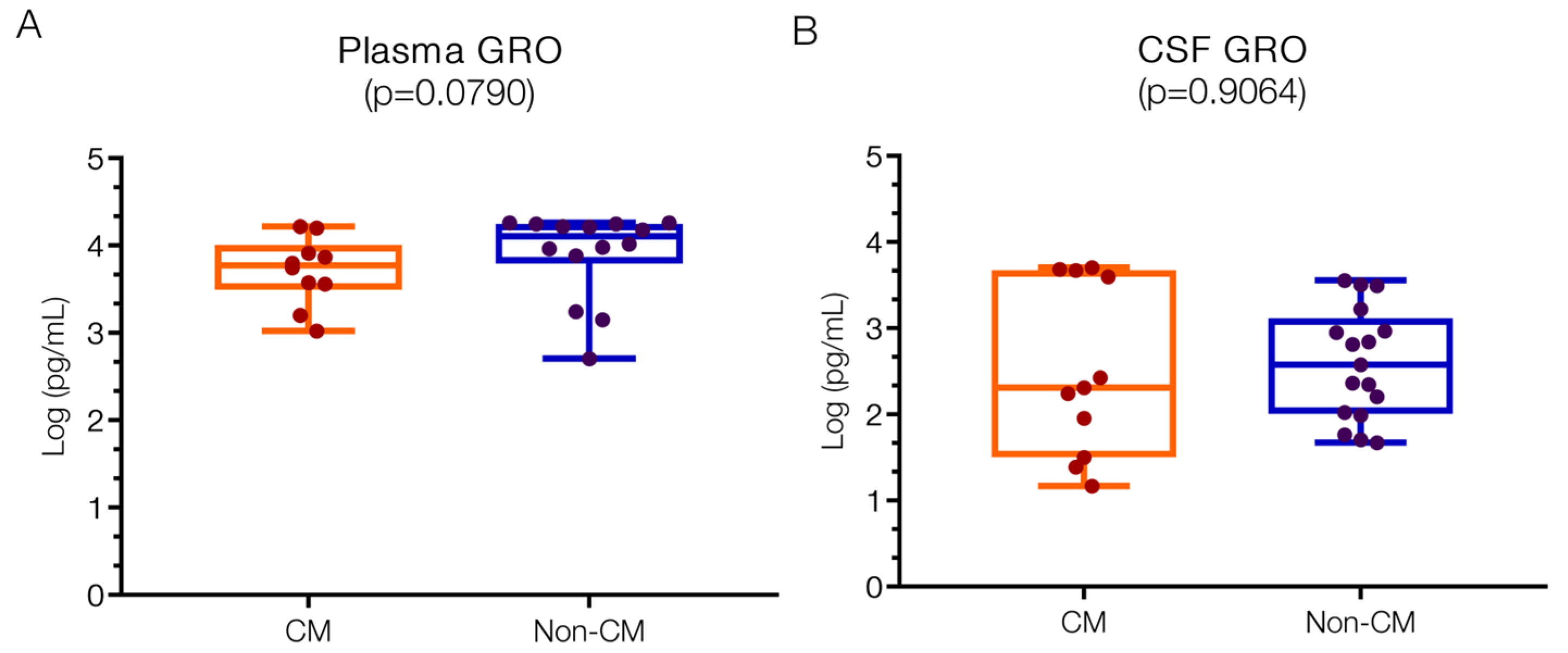
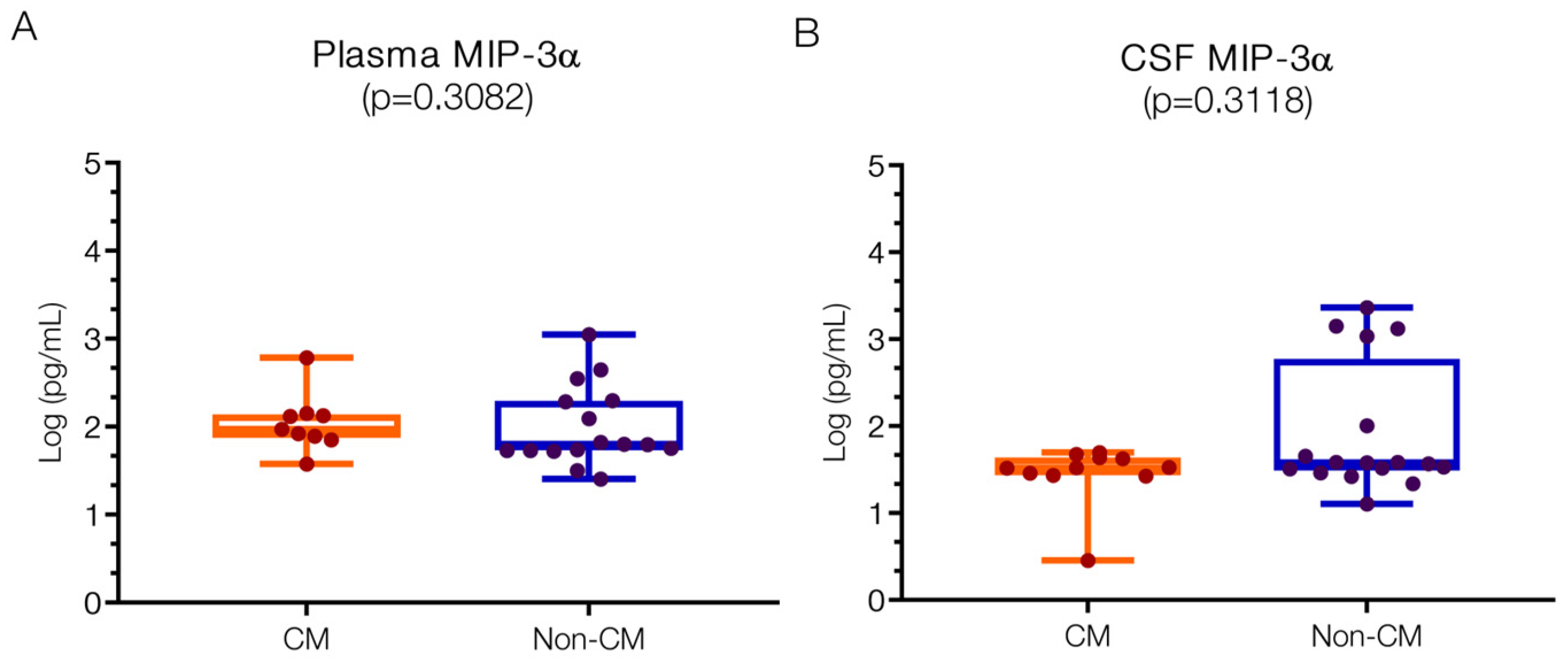
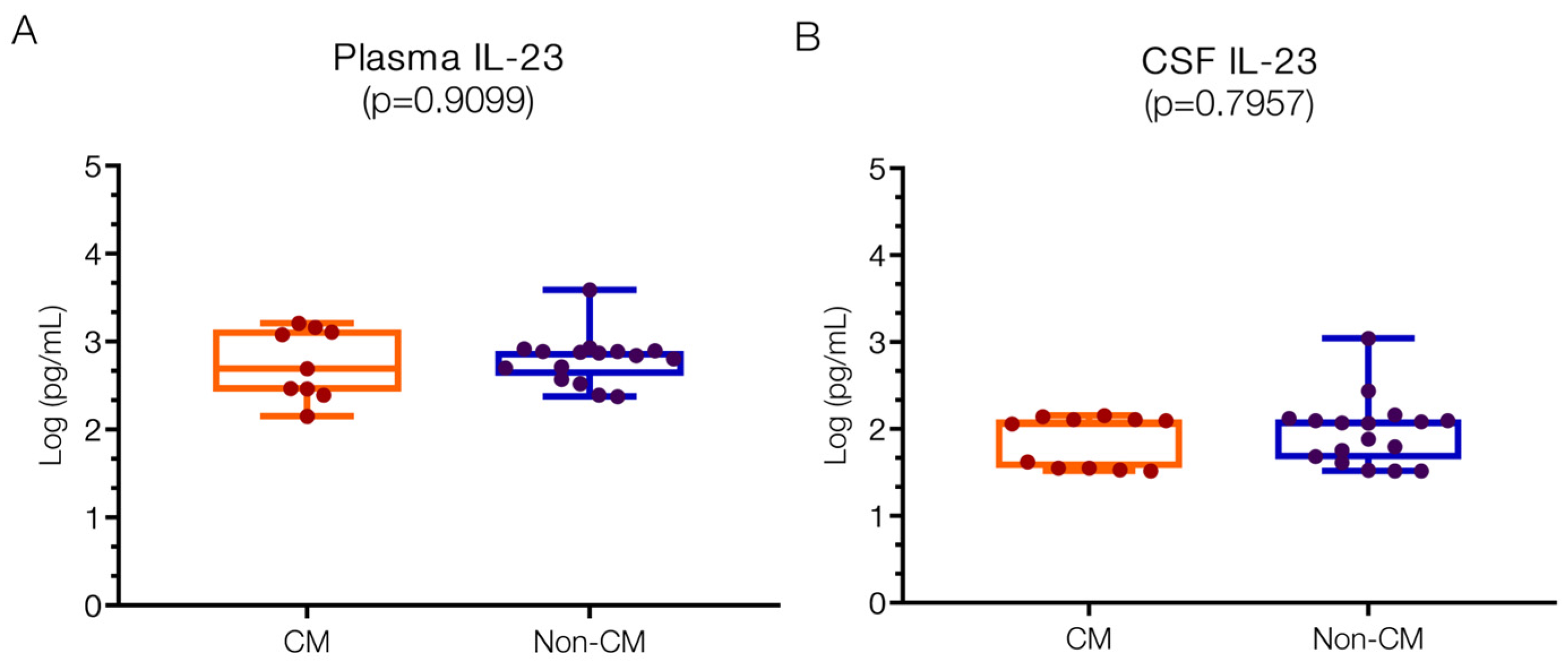
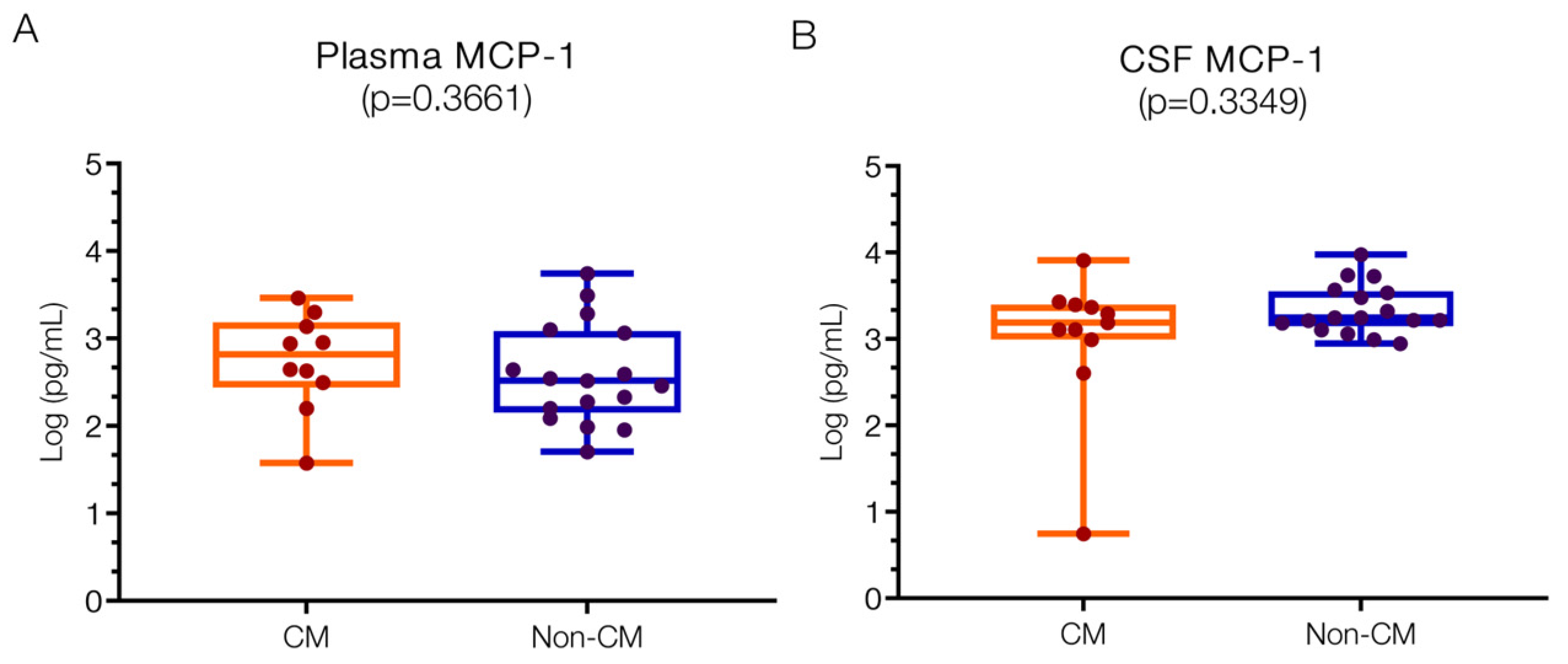
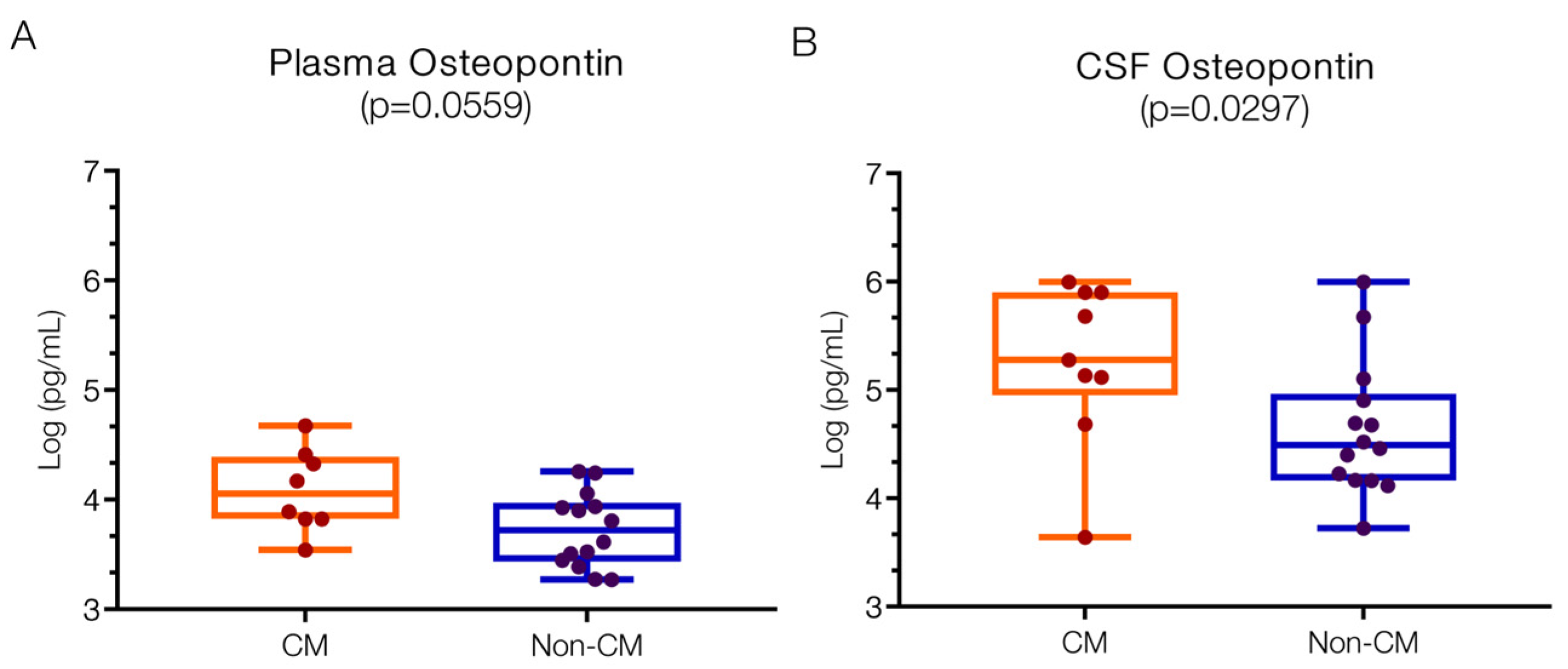

| Variable | CM (n = 11) | non-CM (n = 17) | Total (N = 28) | p Value |
|---|---|---|---|---|
| Demographics | ||||
| Female (%) | 6 (54.55) | 6 (35.29) | 12 (42.86) | 0.444 |
| Age (years) | 4.00 (3.11–4.9) | 2.50 (2.00–9.00) | 4.00 (2.31–6.10) | 0.689 |
| Medical history | ||||
| Epilepsy (%) | 1 (9.09) | 0 (0.00) | 1 (3.57) | 0.393 |
| Cerebral malaria (%) | 1 (9.09) | 0 (0.00) | 1 (3.57) | 0.393 |
| Anemia (%) | 3 (27.27) | 2 (11.76) | 5 (17.86) | 0.353 |
| Transfusions (%) | 0 (0.00) | 1 (5.88) | 1 (3.57) | >0.999 |
| Symptoms | ||||
| Fever (>7 days) (%) | 1 (9.09) | 2 (11.76) | 3 (10.71) | >0.999 |
| Headache (%) | 7 (63.64) | 11 (64.70) | 18 (64.29) | >0.999 |
| Vomit (%) | 7 (63.64) | 6 (35.29) | 13 (46.43) | 0.347 |
| Diarrhea (%) | 4 (36.36) | 7 (41.17) | 11 (39.29) | 0.703 |
| Cough (%) | 3 (27.27) | 9 (52.94) | 12 (42.86) | 0.378 |
| Seizures (%) | 8 (72.72) | 7 (43.75) | 15 (53.57) | 0.134 |
| Physical examination | ||||
| Weight (kg) | 16.00 (13.00–20.00) | 12.00 (8.60–26.50) | 14.00 (10.80–25.10) | 0.384 |
| Temperature (°C) | 38.10 (36.90–39.20) | 38.90 (37.80–39.20) | 38.80 (37.70–39.20) | 0.322 |
| Pyrexia (%) | 10 (90.91) | 16 (94.12) | 26 (92.86) | >0.999 |
| Pallor (%) | 7 (63.64) | 2 (11.76) | 9 (32.14) | 0.010 |
| Jaundice (%) | 3 (27.27) | 1 (5.88) | 4 (14.29) | 0.269 |
| Respiratory distress (%) | 1 (9.09) | 1 (5.88) | 2 (7.14) | >0.999 |
| Pediatric GCS (score) | 8.00 (8.00–9.00) | 10.00 (9.00–15.00) | 9.00 (8.00–12.00) | 0.015 |
| Variable | CM (n = 11) | non-CM (n = 17) | Total (N = 28) | p Value |
|---|---|---|---|---|
| Blood | ||||
| Hemoglobin (g/dL) | 8.50 (8.40–9.60) | 10.90 (9.20–11.40) | 10.20 (8.40–11.40) | 0.083 |
| Hematocrit (%) | 27.00 (25.10–30.00) | 32.70 (29.30–35.50) | 31.10 (25.90–35.50) | 0.053 |
| Red blood cells (106/μL) | 3.51 (3.23–4.25) | 4.42 (4.05–4.67) | 4.16 (3.50–4.60) | 0.034 |
| MCV (fL) | 76.25 (74.10–78.60) | 76.30 (72.40–83.60) | 76.30 (72.40–83.60) | 0.802 |
| MCH (pg/cell) | 25.00 (24.60–26.60) | 26.10 (23.00–26.70) | 25.20 (23.30–26.70) | 0.802 |
| MCHC (g/dL) | 33.05 (32.00–33.90) | 32.90 (31.60–34.10) | 32.90 (31.60–33.90) | 0.919 |
| Platelets (109/L) | 67.50 (59.00–161.00) | 246.00 (193.00–383.00) | 221.00 (70.00–348.00) | 0.009 |
| PDW (%) | 13.90 (10.90–15.85) | 12.45 (11.90–13.65) | 12.65 (11.30–14.05) | 0.426 |
| White blood cells (109/L) | 9.37 (8.80–12.42) | 10.97 (10.63–17.41) | 10.96 (8.80–13.82) | 0.292 |
| Neutrophils (109/L) | 5.96 (4.23–7.31) | 6.45 (4.52–10.09) | 6.04 (4.32–8.26) | 0.457 |
| Lymphocytes (109/L) | 2.32 (1.84–2.82) | 1.67 (1.20–2.67) | 2.17 (1.43–2.67) | 0.244 |
| Monocytes (109/L) | 0.87 (0.76–1.14) | 0.69 (0.54–1.34) | 0.86 (0.62–1.14) | 0.978 |
| Eosinophils (109/L) | 0.21 (0.02–0.41) | 0.22 (0.02–0.39) | 0.22 (0.02–0.41) | >0.999 |
| Basophils (109/L) | 0.07 (0.03–0.16) | 0.01 (0.01–0.05) | 0.04 (0.01–0.06) | 0.035 |
| Total protein (g/L) | 65.00 (61.00–68.20) | 78.10 (71.60–81.30) | 70.80 (65.00–79.10) | <0.001 |
| Albumin (g/L) | 40.80 (35.40–43.70) | 41.60 (33.50–45.80) | 41.40 (35.40–45.10) | 0.452 |
| ALT (U/L) | 39.00 (23.00–46.70) | 23.80 (11.00–32.20) | 25.40 (18.90–39.20) | 0.076 |
| AST (U/L) | 72.70 (57.10–142.80) | 60.40 (34.10–72.10) | 64.25 (36.70–92.30) | 0.192 |
| Sodium (mEq/L) | 134.00 (132.00–136.00) | 132.00 (128.50–135.00) | 133.00 (130.00–135.00) | 0.330 |
| Chloride (mEq/L) | 100.00 (99.00–101.00) | 98.20 (96.15–100.95) | 99.10 (96.60–101.00) | 0.229 |
| Potassium (mEq/L) | 4.50 (4.20–5.44) | 4.14 (3.58–5.55) | 4.20 (3.71–5.44) | 0.139 |
| Urea (mmol/L) | 5.04 (4.88–8.91) | 3.52 (2.76–5.12) | 4.59 (3.14–6.44) | 0.022 |
| Creatinine (μmol/L) | 34.80 (24.50–48.00) | 38.90 (31.70–48.90) | 38.90 (26.10–48.00) | 0.506 |
| Cerebrospinal fluid | ||||
| Increased WBC (%) | 1 (9.09) | 9 (52.94) | 10 (35.71) | 0.041 |
| Increased RBC (%) | 1 (9.09) | 7 (41.18) | 8 (28.57) | 0.099 |
| Glucose (mg/dL) | 90.00 (82.62–93.60) | 77.49 (71.28–90.36) | 88.02 (74.16–91.08) | 0.027 |
| Chloride (mEq/L) | 123.00 (120.00–126.00) | 120.00 (118.00–122.00) | 121.00 (119.00–125.00) | 0.088 |
Disclaimer/Publisher’s Note: The statements, opinions and data contained in all publications are solely those of the individual author(s) and contributor(s) and not of MDPI and/or the editor(s). MDPI and/or the editor(s) disclaim responsibility for any injury to people or property resulting from any ideas, methods, instructions or products referred to in the content. |
© 2024 by the authors. Licensee MDPI, Basel, Switzerland. This article is an open access article distributed under the terms and conditions of the Creative Commons Attribution (CC BY) license (https://creativecommons.org/licenses/by/4.0/).
Share and Cite
Stins, M.F.; Mtaja, A.; Mulendele, E.; Mwimbe, D.; Pinilla-Monsalve, G.D.; Mutengo, M.; Pardo, C.A.; Chipeta, J. Inflammation and Elevated Osteopontin in Plasma and CSF in Cerebral Malaria Compared to Plasmodium-Negative Neurological Infections. Int. J. Mol. Sci. 2024, 25, 9620. https://doi.org/10.3390/ijms25179620
Stins MF, Mtaja A, Mulendele E, Mwimbe D, Pinilla-Monsalve GD, Mutengo M, Pardo CA, Chipeta J. Inflammation and Elevated Osteopontin in Plasma and CSF in Cerebral Malaria Compared to Plasmodium-Negative Neurological Infections. International Journal of Molecular Sciences. 2024; 25(17):9620. https://doi.org/10.3390/ijms25179620
Chicago/Turabian StyleStins, Monique F., Agnes Mtaja, Evans Mulendele, Daniel Mwimbe, Gabriel D. Pinilla-Monsalve, Mable Mutengo, Carlos A. Pardo, and James Chipeta. 2024. "Inflammation and Elevated Osteopontin in Plasma and CSF in Cerebral Malaria Compared to Plasmodium-Negative Neurological Infections" International Journal of Molecular Sciences 25, no. 17: 9620. https://doi.org/10.3390/ijms25179620
APA StyleStins, M. F., Mtaja, A., Mulendele, E., Mwimbe, D., Pinilla-Monsalve, G. D., Mutengo, M., Pardo, C. A., & Chipeta, J. (2024). Inflammation and Elevated Osteopontin in Plasma and CSF in Cerebral Malaria Compared to Plasmodium-Negative Neurological Infections. International Journal of Molecular Sciences, 25(17), 9620. https://doi.org/10.3390/ijms25179620






